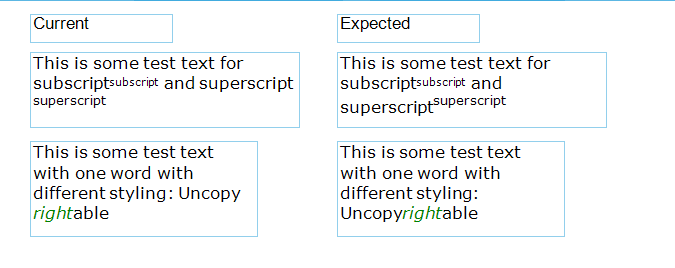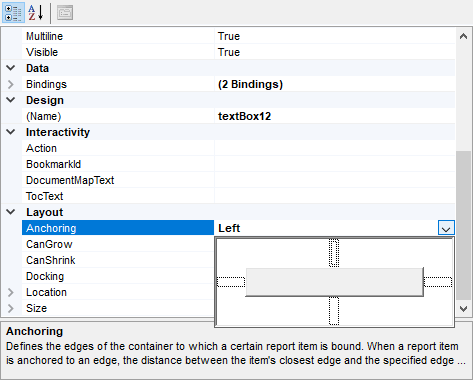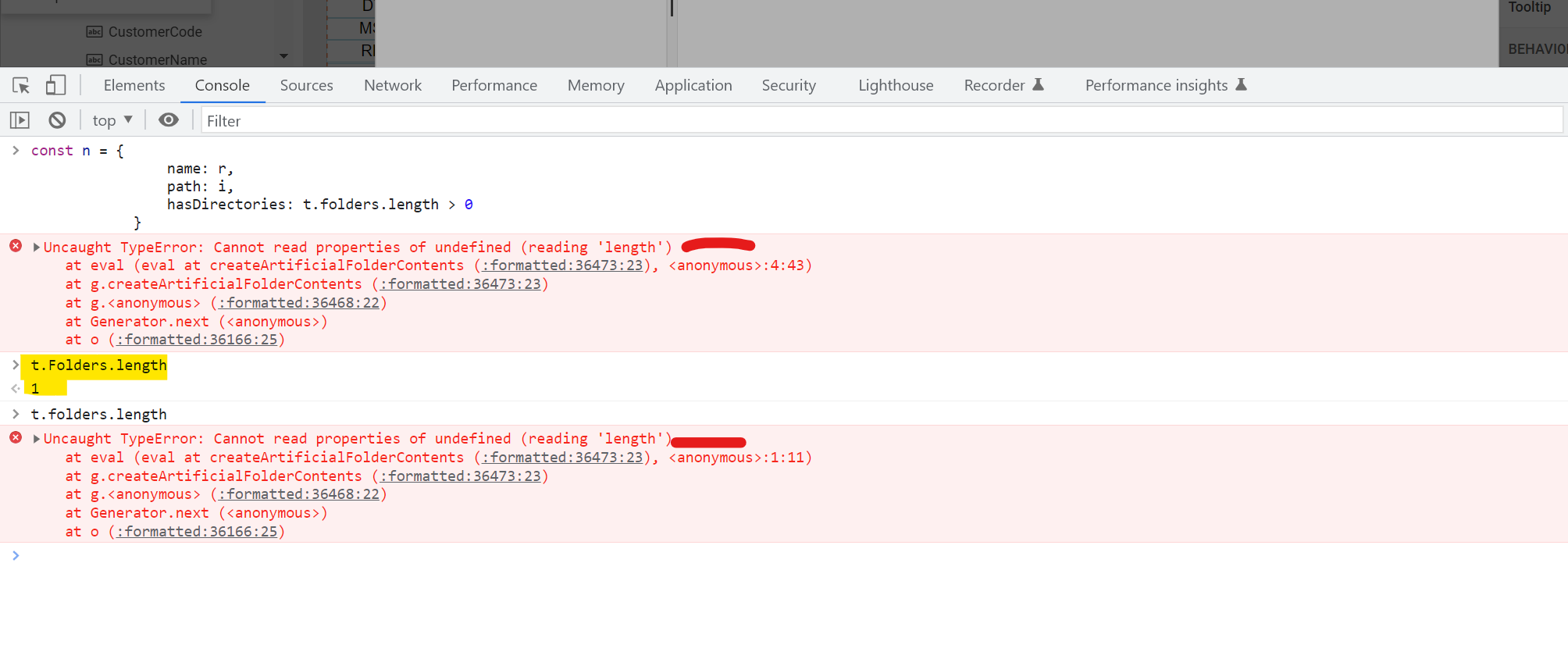According to the Excel Rendering Design Considerations article:
- The "f" DateTime format string should result in a full date/time pattern with a short time pattern.
- The "F" DateTime format string should result in a full date/time pattern with a long time pattern.
After exporting to XLS/XLSX, the time formats are as follows:
- "f" -> full date/time pattern with a long time pattern.
- "F" -> full date/time pattern with a short time pattern.
In the Explorer tab of the Web Report Designer, when trying to open the context menu of a table(crosstab)'s column(row) group, nothing happens and an error is logged in the browser console.
Steps to reproduce:
- Navigate to a table(crosstab)'s column/row group in the Explorer tab.
- Try to open the context menu with the ellipsis button (...).
When the "Kind" localization property of the Web Report Designer is changed, the ExternalStyleSheets editor breaks, and it cannot be used.
Hardcoded values are used when checking against "LocalizedName" in a few other places as well. Some of which are:
- "Kind" === e.LocalizedName
- "Path" === e.LocalizedName
- "Path" !== e.LocalizedName
- "Width" === this.LocalizedName
- "Height" === this.LocalizedName
Hello,
in the WebReportDesigner it is currently only possible to add a TypeSelector to a StyleRule. (see screenShot: "WRD_StyleRule_Add_Selector.png").
Interestingly, when a report already contains a StyleSelector, it is possible to edit and save the changes, this is great :-), (see screenShot: "WRD_StyleRule_Edit_StyleSelector.png").
Would be great if we could add a StyleSelector ;-).
Best regards
Alexander Schneider
The attached 'Test.svg' image markup file contains 'use' statements that lead to duplicating part of the image parts when rendering the report in PDF.
The other file in the archive, 'Test-noUsings.svg' is the same image without 'use' statements and doesn't have this problem.
Hello Support-Team,
in the WebReportDesigner, the Edit-Window shows "undefined" for the FieldNames, when selected a second Time.
This is also reproduceable in the demo application: https://demos.telerik.com/reporting/designer.
(see Screenshot in attached Files)
Steps to repoduce:
1. Open the Edit-Window for a TextBox (with a DataSource)
2. Select the DataSource-Entry.
3. Select some other Entry, e.g. "Report Parameters"
4. Select the DataSource-Entry.
Best regards
Alexander Schneider
System Development | Loy & Hutz Solutions GmbH
P.S. It seems more logical to me to implement text wrapping using spaces rather than spaces + tags used, as it is now. But the support team have assured me that this is not possible.
If you set the anchor property and validate it, if I come back on the property, the designer does not show the current anchor.
As you can see, anchoring is defined to left, but it is not shown in the dropdown of the property. The anchoring left should be grey.
When selecting an item in the report designer (for instance a textbox) if i go in the properties and i set the anchoring property, i have to click in an other property to get my anchor property to be updated.
I have attached a video that reproduce the problem :
Select a textbox, go to anchoring in the property explorer
Set the anchoring
And click in the report itself
As you can see anchoring property hasn't been updated.
I noticed that using the Standalone Report Designer for .NET, I can't open the "ReportSource" dialog for a SubReport. The property cannot be edited from the Properties tab either.
Instead, when using the Standalone Report Designer for .NET Framework everything works fine.
When developing a Telerik report template with the intention of exporting to Excel, I observed the % sign was not displaying for positive numbers in the exported Excel file. The format we were using was {0:N2}%. The results displayed on the HTML report viewer and the Word export document was correct:
However in the excel file result, the cells were formatted without the % for positive numbers, and with the % for negative numbers.
Upon further inspection, I noticed the excel cell formatting was translated as:
This format would not generate the % symbol for a positive number as the trailing % is missing before the semi-colon.
We are fixing this by using the below Format specification directly in the Report Designer:
{0:#,##0.00"%";-#,##0.00"%"}
which is directly retained in the excel custom format:
While I understand that N, C etc. C# number formats are supported according to the design considerations and this bug is also technically resolved by using UseExtendedFormatting (setting this to false translates {0:N2} to #,##0.00"%"), this seems like an unexpected result of translating the format codes that does not match the standard behavior of {0:N2}%. Reporting this behavior for review.
The JS file with the stringResources shipped with the installation at the following location:
C:\Program Files (x86)\Progress\Telerik Reporting <Release>\Html5\ReportViewer\js
is incorrect, it should be as shown in the Localization - Telerik Reporting article.
Basically, line 9 should be changed to:
; (function (trv, $) {while lines 178 to 180 should be like this:
trv.sr = $.extend(trv.sr, sr);
}(window.telerikReportViewer = window.telerikReportViewer || {}, jQuery));When HTML entities are used in an embedded expression of the HtmlTextBox, they are parsed.
The same does not happen when the "= ..." expression syntax is used.
For example:
This expression works.
= Replace(Fields.Column2, 'less than','<')This one throws an error.
{Replace(Fields.Column2, 'less than','<')}
Utilizing Native Blazor Report Viewer with Telerik Blazor UI 4.0 results in some toolbar icons appearing blank. The icons are still functional.
Switching to Blazor UI 3.7 fixes the issue.
Here is a snippet from the file '/@progress/telerik-angular-report-viewer/dist/es/telerik-report-viewer.component.js' in Telerik Reporting NPM repository of the Angular Viewer that hard-codes the message:
TelerikReportViewerComponent.decorators = [
{ type: Component, args: [{
selector: 'tr-viewer',
template: '<div [ngStyle]="containerStyle" [attr.id]="reportViewerID" #container>Loading Report Viewer...</div>',
styleUrls: [],
encapsulation: ViewEncapsulation.None,
},] },
];Currently, there is no easy way for localizing or removing this message in an Angular-wise approach.
The DocumentMapVisible/ParametersAreaVisible settings that I set in the initialization of the native Blazor Report Viewer are not respected.
I can hide/show these areas from the buttons in the report viewer's toolbar but am unable to have them hidden initially.
Currently, the only workaround is to have a JS function that clicks on the toolbar after initialization:
function reportViewerMapClick() {
$(".k-i-dictionary-add").click();
}
In this file t.folder is lowercase which should be Capital t.Folder
t.folder throws error
t.Folder return value
same or files vs Files
Currently, I am using XmlSerializer to deserialize .trdx file, and it returns Telerik.Reporting.Report type object.
Since, for a long time, I need to add my own functions to be available in the report's expressions, and this need becomes larger and larger, it would be great if I could use the Telerik.Reporting.XmlSerialization.ReportXmlSerializer class to deserialize the .trdx file in my derived class.
For example:
var report = new Telerik.Reporting.XmlSerialization.ReportXmlSerializer().Deserialize<MyReportDerivedClass>(TemplateStream);For example:
Item("MyProperty",Fields.MyDictionary)This would add a invaluable degree of freedom when considering the structure and usage of report's datasources. For example, the current way of working with ExpandoObject (which are also IDictionaries) is very problematic and in my opinion not a good way of doing it. One such utility function will eliminate almost all of the problems that are present at the moment.
Another way (even better) would be to make something like:
Fields("MyProperty")If both ways are added, this will completely (in my opinion) eliminate all the problems using dictionaries and expando objects in reporting.







